
Product test
The Model O Eternal is a great budget gaming mouse
by Kevin Hofer
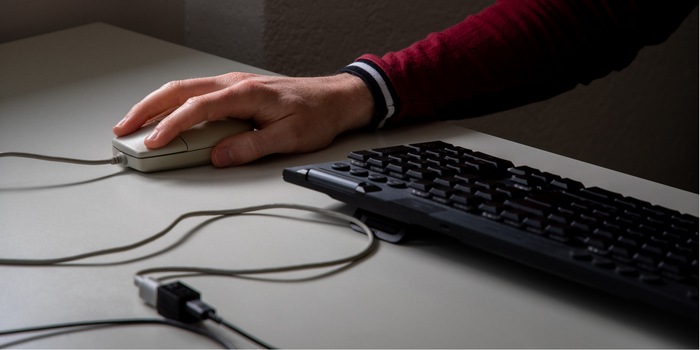
Can I use a 30-year-old Macintosh mouse on a modern computer? Technically yes. But it’s about as useful as a CRT monitor these days.
Here I sit, working with a mouse that lacks even the most basic of functionality, such as a right mouse button or a scroll wheel. It creaks at the slightest touch, and constantly appears on the verge of breaking. It is, I must admit, quite tedious.
Why am I doing this to myself? Because I can. And because I want to experience first-hand how much mouse technology has progressed in the last 30 years.
A small but useful adapter from Drakware made this experiment possible. You sadly can’t buy it with us, probably because there’s no market for it. The adapter is something of a one-off: it was obviously produced with a 3D printer, as you can see the typical grooves that appear when the individual layers are applied.
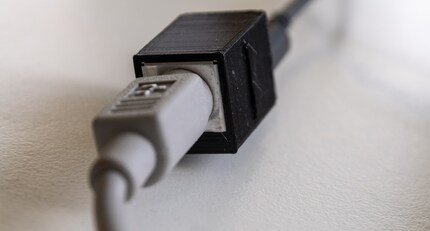
The device is called ADB2USB. ADB, or Apple Desktop Bus, was the interface for mice and keyboards on Macintosh computers from 1986 to 1998. With the adapter, these antique peripherals can be connected to a modern computer via USB.
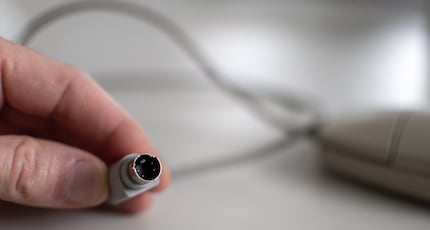
It works. The mouse pointer moves around my screen and responds whenever I click. However, this doesn’t mean that the mouse is useful for everyday use.
Until 2005, all Apple mice had only one button. This was apparently done to make it as easy as possible to use. But as computers became more capable, mice inevitably became more complicated. Even in the 1990s, single-key mice no longer did justice to the complexity of contemporary applications. But instead of introducing a second button, Apple invented the control click: holding down ctrl while clicking would act the same as a right-click. Which completely nullifies the ease of access argument. But that’s irrelevant, here’s all that matters now: this simulated right-click still works on Mac today; therefore, I can still work with a single-key mouse during my trial.
What I’m missing even more than any right mouse button is a scroll wheel. I caught myself trying to scroll on multiple occasions, despite knowing that I couldn’t. It’s a reflex, what can I say.
Dragging scrollbars is quite cumbersome compared to simply using a scroll wheel. How did we even manage in the past? I was particularly annoyed by those endlessly scrolling websites, sites that have become more and more common in recent years. With them, the scroll bar jumps up the page while my mouse pointer remains where I left it. I have to release the mouse button and go back up again to scroll further.
I also miss the back and forward buttons that I’ve grown to love when browsing. The clicking noise emitted by the single button is quite loud, and mouse creaks near constantly. I couldn’t tell you whether this has always been the case or whether it’s due to the old age of the device.
At first, the mouse cursor moved across the screen at a snail’s pace. Even when I set the mouse speed to the highest level, it was still too slow. No wonder: the mouse only ever gets to 100 CPI (characters per inch). Meaning that the cursor moves 100 units on-screen once every 2.54 centimetres I move the mouse. This was enough for the intended Macintosh, with its screen resolution of 512 × 342 pixels. Today, we’ve got mice that offer up to 18,000 CPI.
Using a simple intervention in Terminal – the command line interface for macOS – you can increase the default mouse speed far beyond what is possible in the system preferences. After a restart, the mouse cursor finally zooms across my screen at an appropriate speed. But as the resolution still remains low, it lacks precision. Quickly and precisely navigating to a small icon on a large screen is harder than ever. But it’s still better than a lethargic mouse.
I determined the CPI value using the benchmark tool «Mousetester». The app only runs on Windows. Fortunately, the ADB adapter works with it just fine. However, working with the mouse on Windows is even harder than on Mac.
My colleague Kevin Hofer uses MouseTester for his reviews. But they do deliver quite boring results: today, hardly any weaknesses can be detected with the tool – and if they are, actual differences between mice are negligible. It’s nice to have a mouse with glaring weaknesses.
I paid particularly close attention to the acceleration and jitter factors. When testing acceleration, I quickly moved the mouse in one direction before slowly tracing the same line back to the point of origin. The tool records all registered characters. Ideally, forward and backward movement should trace along the same axis. A new Logitech Pro X Superlight looks something like this:
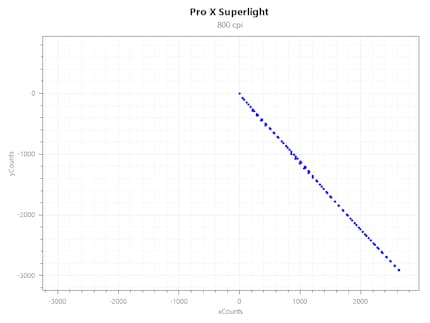
A perfect line equates to perfect performance. This isn’t the case with Apple’s Desktop Mouse II.
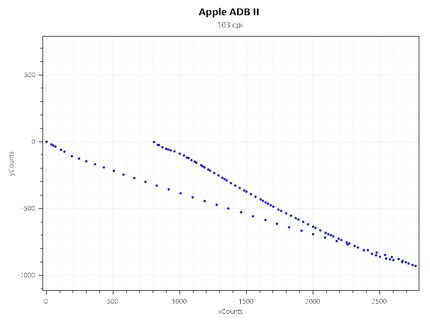
Here the lines are far apart, and the point of origin is completely off as well.
When testing jitter, i.e. dithering during the transmission of digital signals, the mouse is moved across a table in a diagonal line using a ruler. The tool records all registered characters. Again, the Logitech G Pro X Superlight delivers a perfect line:

Once again, the Apple Desktop Mouse II struggles. The line is anything but straight.
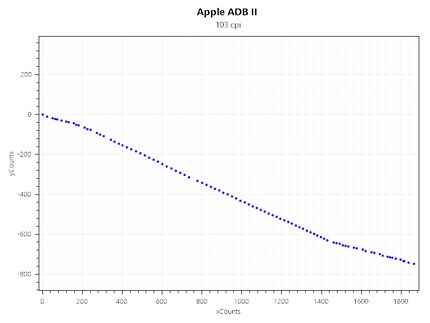
The deviations certainly also have to do with the fact that this isn’t an optical, but a mechanical mouse. It contains the now iconic hard-boiled egg rubber ball. When moving the mouse, the ball spins due to friction caused by my desk. The movement of the ball in turn moves two rollers inside the mouse, one for the x-axis and one for the y-axis. These then send a motion signal to the computer.
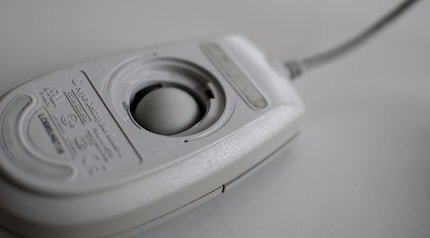
MouseTester also gives me a polling rate. It’s at 64 Hz. This means that an update is sent to the computer every 15 ms. These days, 1000 Hz is the norm. However, there are already mice with 8000 Hz. If you ever want to beat a pro gamer, you’ll just need to convince them to play with this mouse.
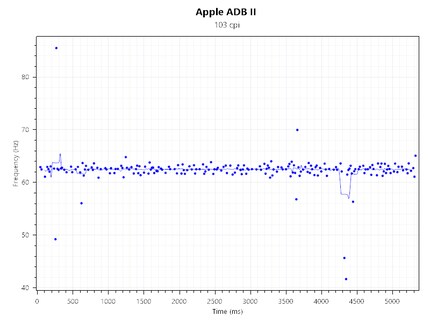
The mouse is laughably bad in all aspects according to today’s standards. From the start, it’s simply unbearable. What I find amazing, though, is how quickly I get used to it. After a few – admittedly tough – hours of office work, I almost forgot about modern conveniences such as scroll wheels and right mouse buttons. But only just. And I’ll never get used to that annoying creaking noise.
My interest in IT and writing landed me in tech journalism early on (2000). I want to know how we can use technology without being used. Outside of the office, I’m a keen musician who makes up for lacking talent with excessive enthusiasm.